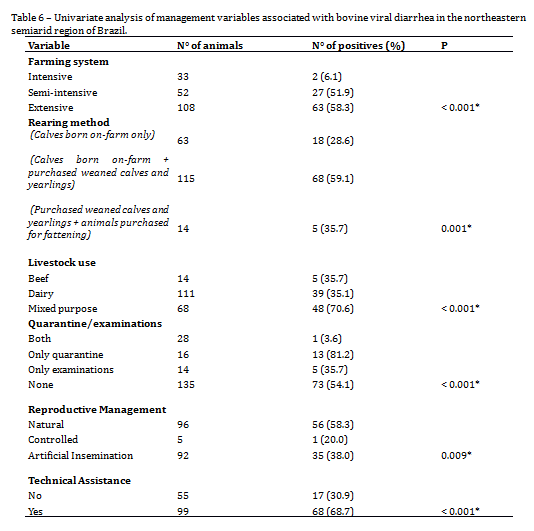Frequency and risk factors associated with the bovine viral diarrhea virus in herds in the semiarid region of the states of Bahia and Pernambuco, Brazil
DOI:
https://doi.org/10.21708/avb.2019.13.3.8554Abstract
Bovine viral diarrhea virus (BVDV) is an important viral pathogen in cattle. There are a few reports of this disease in northeastern Brazil, mainly in the semiarid region. The goal of this study was to determine both the frequency of seropositive animals, and the risk factors for BVDV in the municipalities of Bahia and Pernambuco. A non-probabilistic sampling was initially employed to determine the properties to be visited, whereas a probabilistic sampling was used to determine the number of animals per property. Serum samples were submitted to a seroneutralization test to determine the antibody titer for BVDV. An epidemiological questionnaire was used in the herds to evaluate the correlation and association between possible risk factors and BVDV infection in these herds. Of the 257 animals in the study, 144 were positive for infection BVDV, resulting in an overall frequency of 56.0%. The highest frequency was observed in Miguel Calmon (76.1%) and followed by Senhor do Bonfim (53.1%). The variables identified as risk factors for the BVDV infection were an extensive breeding system (OR = 2.58) and a mixed livestock purpose (beef and dairy) (OR = 3.32). The presence of BVDV-seropositive animals in the assessed municipalities suggests the circulation of the viral agent in these locations. Therefore, control and preventive measures must be implemented in order to minimize losses due to the disease, such as monitoring of the properties through laboratory tests, elimination of infected animals, and the use of vaccines in the indicated regions by the animal health department.
Downloads

Downloads
Pubblicato
Fascicolo
Sezione
Licenza
Autores que publicam na Acta Veterinaria Brasilica concordam com os seguintes termos: a) Autores mantém os direitos autorais e concedem à revista o direito de primeira publicação, com o trabalho simultaneamente licenciado sob a Licença Creative Commons Attribution que permite o compartilhamento do trabalho com reconhecimento da autoria e publicação inicial nesta revista. b) Autores têm autorização para assumir contratos adicionais separadamente, para distribuição não-exclusiva da versão do trabalho publicada nesta revista (ex.: publicar em repositório institucional ou como capítulo de livro), com reconhecimento de autoria e publicação inicial nesta revista. c) Autores têm permissão e são estimulados a publicar e distribuir seu trabalho online (ex.: em repositórios institucionais ou na sua página pessoal) a qualquer ponto antes ou durante o processo editorial, já que isso pode gerar alterações produtivas, bem como aumentar o impacto e a citação do trabalho publicado (Veja O Efeito do Acesso Livre).


 Esta obra está licenciada com uma Licença
Esta obra está licenciada com uma Licença 